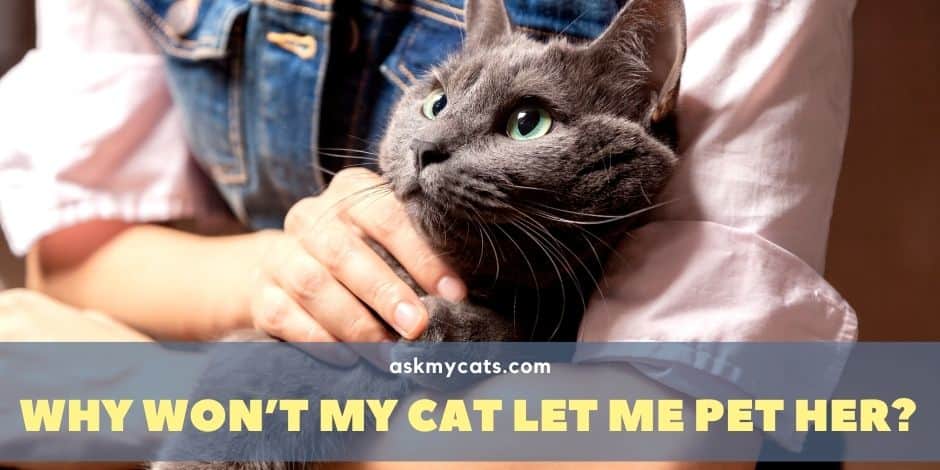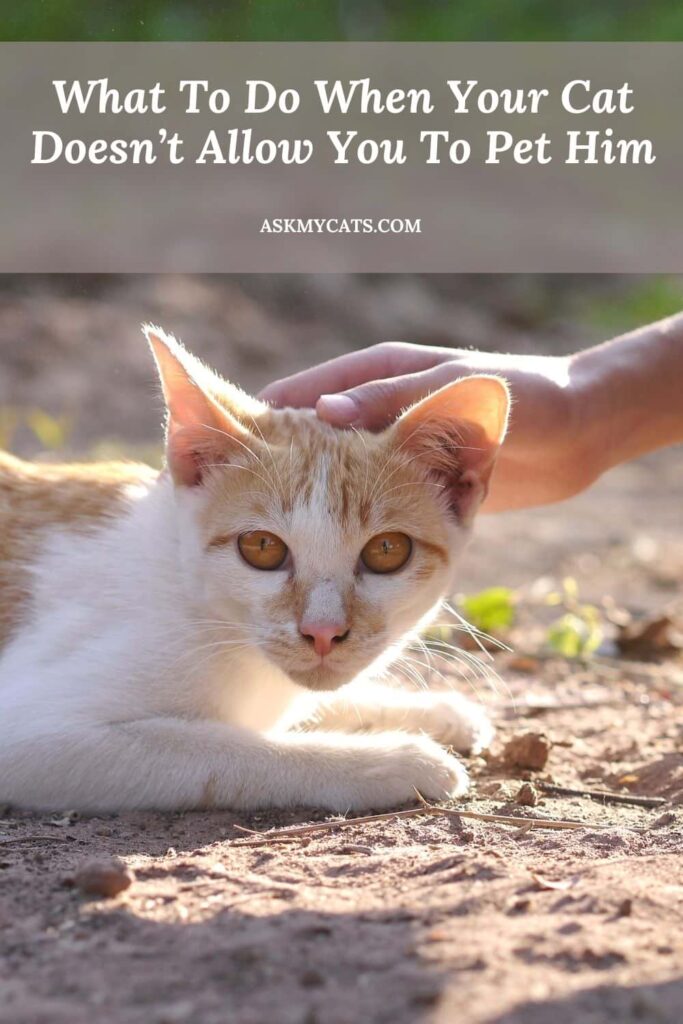It’s difficult to comprehend our feline companions fully. They have a habit of acting strange. Like, they can unexpectedly lick their owners’ eyes.
When we pet dogs and cats for the first time, often first-time cat owners make the mistake of expecting the same response.
Your cat may not let you pet her because of her age, your cat can unexpectedly become averse to being approached. This has been seen in kittens that, as they get older, spontaneously refuse to be touched. Hormonal fluctuations, as well as physical growth, are commonly blamed.
Dogs enjoy receiving human love. Cats, on the other hand, behave strangely sometimes and dislike being touched while they are stressed.
According to researchers, true pet owners should stop contacting the cat often if they find that their cat doesn’t like that. Pet owners cannot compel cats to love them.
To keep a happy cat household, read this article to learn about the circumstances in which you can stop petting a cat.


Give Your Cat the Perfect Day
Get the Free Ebook!
Possible Reasons Why Doesn’t Cat Lets You Pet Him?

1. What’s His Mood?
Mind, though, that your cat does not want to be cuddled in the way you want.
My cat will not sit on my lap (with the exception of only two seconds longer than it takes to get a treat) but will purr to a bursting point when I pick it up and be happy to be held around for a bit, cuddled, with my chin rubbing his back.
So don’t bother about the type of affection (which will change over time anyway) as long as the state of affection is conveyed.
Don’t miss this article where you will get to know how a cat’s mood drives him to become fond of chocolate ice-creams!
2. Change Your Approach
The thing that gives your cat panic attacks might be your approach towards him. Approach him in a different direction. Don’t look over the cat, or put your face close to his.
Don’t drop your hand from above his head or plop it down heavily. Take a bent index finger and try stroking his cheek, or run your hand from the base of his neck to his tail. Just do it once.
The intention is to make him like it and ask for more, but not to push. Sit cross-legged and pet his shoulder, encouraging him to sit in your lap to see what he’s doing.
Give a couple of treats. Trying to hug him to your side really briefly with one arm and let him go quickly.
Or take the pole that carries the string on a cat toy and softly stroke it from a distance. He might feel happier about it.
3. Way Of Love
The more she gets used to your side, the more often she will learn to appreciate it, and even enjoy it.
Only take your time with her and let her show you what she wants and doesn’t want. Some cats don’t want their belly scratched or rubbed, and still, they enjoy it!
She’s going to lead you through her unexpected disliking display.
You never know what a cat may like since they love the most to lick at their partner’s bums!
Also, check out why doesn’t my cat like to be held
4. Hidden Trauma
When cats are glum or stressed, they sometimes don’t want to be handled. Petting the cats at those times does little to alleviate their tension.
It irritates them more, and they may react by scratching or fleeing. If a cat sits beside a window and crinkles its paws, it is indicating that the cat is anxious.
Petting them at that time may aggravate them even further, and the cat may flee. Such actions may be triggered by some alteration of schedule or living environment.
When a cat owner offers a certain kind of food to their cat, or if there is a new animal or person in the home, cats need time to adapt.
5. Wrong Place To Pet?
With the exception of temperament, pet owners should remember another factor when touching a cat. Often double-check the position of the cat you’re petting.
Experts claim there are four good ones and one poor one.
The following are the four areas that you can pet:
- Chin’s foundation
- Behind the whiskers, behind the cheeks
- Ears’ foundation
- The tails’ base
The belly of the cat is one spot you can never go. Cats will expose their belly if they are at ease with their parents, but they despise belly scratching. (Although every cat is different, these are general likings and dislikings which might differ with every cat)
You might also like to read about Why Won’t My Cat Cuddle With Me Anymore?
6. Know The Emotions
Adopted cats often suffer from mental distress and a natural aversion to humans. It takes time for cats from shelters to become used to other cats or humans, and it is best not to contact them during this time.
If a cat has experienced some kind of threat or discomfort, it can become violent. To make cats more appropriate, it is recommended that you seek the advice of a veterinarian.
Every cat is different, and their circumstances can differ from one to the next. If their response to petting changes abruptly, it’s important to investigate what’s changed.
7. Aggressive Kitty
Another cat in the area could be bullied because the cat is most likely anxious. Because of hormone fluctuations, kittens exhibit a drastic shift in behavior when they approach a certain era.
Excessive touching or petting may make them violent. Feline dementia is a common ailment in older animals, and this may be the cause.
This form of behavioral adjustment is often the cause of a change in petting response.
The abrupt change in behavior may also be a sign of physical discomfort. Pain in cats can be caused by a variety of factors –
- Wounds are there.
- Osteoarthritis Burns Heal as a Result of Surgical Intervention.
If the cat is experiencing all of these issues, it might be in a bad mood. Touching a sore part of the cat’s body will cause them to become distressed and flee.
8. Expressive Kitty
Cats are very vocal, but almost entirely in the language of the body. The location of the head, ears, eyes, tail, and overall body means a lot in a cat’s “conversation.” For example, a slowly blinking cat is like a human smile.
Turn back, tail straight up, tail tip curled or flicking, pointing their ass at you, and take a step away is more or less their way of saying, “I want and admire you, and am glad seeing you,” sort of like a tight embrace from a good friend (or a kiss on each cheek, for the Europeans).
For cats, kissing and sniffing cheeks is a much less intimate greeting, kind of like a formal embrace, if you want to stroke their heads and necks, you have to compel them to sit still.
When they know what you’re doing, they’re going to relax and stop trying to turn around. If you hold them in front of you, don’t look into their eyes, however.
Staring is a symptom of dissatisfaction or defiance, like a frown to people, but if you look into a cat’s eye, try to blink slowly as they do.
You might also like to know the reasons behind a cat doesn’t like being touched on back
What To Do When Your Cat Doesn’t Allow You To Pet Him

Cats that have been left behind for a long time are wary of being treated. Any attempt to force the issue could jeopardize the delicate relationship you’ve worked so hard to build.
So far, everything you’ve done has been flawless. Allow him to get used to the concept of physical touch by being gentle with him. Following are a few suggestions:
When you’re sure he’s starving, spoon-feed him little pieces of dried food. Try hand-feeding some kitty treats if he accepts spoon-feeding.
Sit passively in his presence, speak in soothing tones, and minimize hand gestures and eye contact. To entice him closer, strew catnip or treats on or near your body.
Use a feather or toy tied to a string to engage in any interactive games. Alternatively, clearly dangle a rope in front of him and see if he’ll chase it.
Keep a well-furnished cat carrier in his room with the door ajar. Think of using the area as his “bed” and feeding station. As a result, his first outing to the veterinarian would be less painful.
Enable him to sniff your hand as his comfort level rises, and he will finally climb into your lap.
If and when he does, softly stroke the hair around the back of his body, which is a cat’s favorite pressure spot. Do not pick him up until he accepts gentle petting first.
Also, find out why does my cat not want to be touched
Frequently Asked Questions
Why does my cat flinch when I pet her?
Even the cats flinch when they’re in pain. If your cat has arthritis or falls and has back pain, making someone stroke his neck and back can hurt. The only way to know for sure is to make a vet check him out.
Why does my cat avoid me?
Your cat may unexpectedly ignore you for the following reasons: your cat does not feel the need to communicate with you. Your cat has recalled a traumatic encounter with you. Your cat has been thrown away by a normal shift.
How do you know if your cat doesn’t like you?
Cats can be beautiful, sweet pets—but sometimes you do not like them as much. If your cat has a lowered or puffed-up tail, it might mean that they’re frightened or uncomfortable. Cats could bite you or hiss at you, too, if they’re not your biggest fan.
How do I say sorry to my cat?
Give your pet a little time to cool down, then apologize quietly while looking slowly at them. Remember to compliment your pet and reward them with a treat or a cat. Spending some quality time together, with plenty of petting and games, should make your cat happier.
Why does my cat follow me everywhere but won’t cuddle?
Cats want to pay respect to their own words. It may be that she loves being in your company, but she’s just not in the mood to be picked up or petted. Trying to convince your cat to do something they’re not ready to do might make them dislike you or have a bad experience with being petted. Cats are better suited to new experiences when they are able to run at their own speed.
Why is my cat not affectionate at all?
Although some cats may be ebullient and affectionate, others may be reserved and almost aloof. Much of the time, this is due to variations in human personalities. However, certain cats could be less affectionate since they did not have adequate socialization with humans when they were young.
Final Words
If the cat does not want to be touched, the only thing to do is figure out why. It is important to ensure that the cat is not bothered by the reasons listed above.
Delete it from their living situation if this is the case. If your cat ever won’t let you pet it, consult a veterinarian or a feline ethologist on how to make your cat get habituated.
Let us know what your cat likes and dislikes about the way of petting her, in the comments section below!
